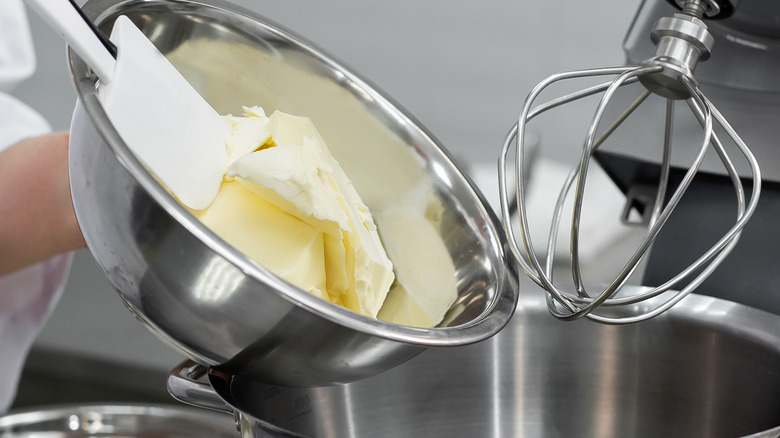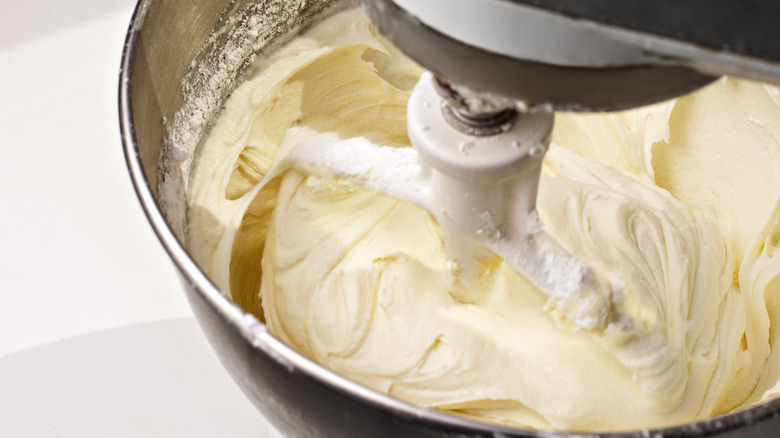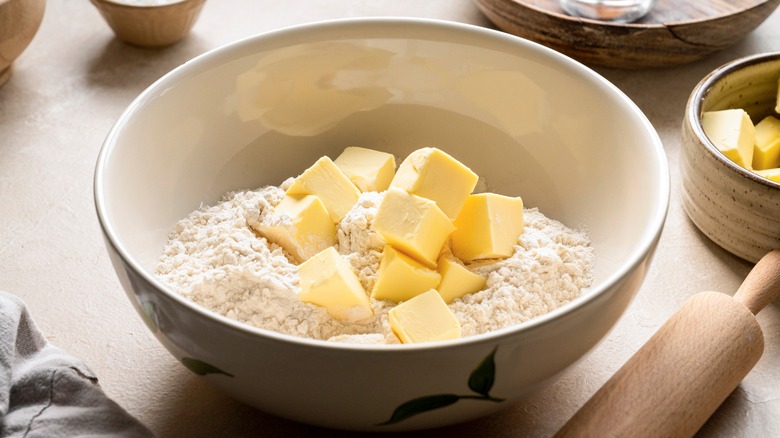What Happens If You Overwork Butter?
When it comes to baking, you're usually going to deal with three forms of butter: melted, softened, and cold. Depending on the dish you're making, the state of matter your butter starts off in is crucial to the overall integrity of the bread or cookie. Light and fluffy dishes like vanilla cake need proper aeration, while dense and crispy pie crusts need less manipulation. But no matter what you are baking, you always have the risk of overworking your butter. Even recipes that call for creaming butter and sugar together into a whipped buttercream can be overmixed beyond saving.
Overworking butter means you're over-mixing the butter with some other ingredient, be it sugar, eggs, or flour. While melted butter is already so broken down that it's hard to overmix, you could still overwork the batter and have a tough and dry result. When you're working with softened or cold butter, there are stricter limitations for mixing that can give you unwanted outcomes. Overall, a good rule of thumb is to follow the recipe's instructions to a tee and also to know some visual cues to look out for when dealing with each kind of baked good.
Overmixing softened butter gives you a greasy mess
Softened butter is butter that's been left at room temperature for around 30 minutes to an hour prior to cooking. The trick with softened butter is that it isn't truly softened, but just more pliable than cold butter. You should be able to leave an indent on it when applying pressure, but it shouldn't be completely squishy. Recipes that call for softened butter are usually for cookies, pound cakes, or a simple buttercream frosting. Softened butter is usually mixed in (or creamed) with sugar to add structure and texture to your cakes and cookies. Creaming is basically whipping softened butter with sugar to create small pockets of air for desserts like sponge cakes.
While it's encouraged to mix the butter and sugar to the point of complete homogenization and lightness, there is a limit to doing so. If you cream your butter beyond the necessary point, it will end up splitting into curdles of milk solids and a pool of oil. At this point, the butter has split into its separate properties and your cake or cookie will lose its shape, or taste too greasy. To prevent overmixing, look out for a pale yellow buttercream with added volume. By the time the mixture turns lighter and bigger, you should stop working the butter.
Overworking cold butter causes melting
Cold butter is reserved for flaky pastries like pie crusts, croissants, and biscuits (although you could also use it for certain cookies). Recipes involving cold butter often call for mixing cold flakes with flour to create a cold dough. While cakes and cookies rely on the tiny air bubbles of the creamed butter for the rise, pies and scones rely on pockets of steam released during the cooking process. It is crucial for your butter to be as cold as possible so that it melts gradually in the oven, releasing bubbles and creating beautiful, flaky layers. If you overmix the cold butter and flour mixture with your hands, chances are your butter will melt as you knead the dough. This inhibits your pie crust and biscuits from forming distinct layers and height. The result will be a deflated, doughy, and tough bread.
There are many tricks to prevent your butter from becoming too warm as you mix your pie dough. You could first slice your butter into cubes or thin slivers, and freeze these bits so that they are small enough to break but too cold to melt immediately. Another hack is to use a food processor to blend the butter and flour together without using warmth from your hand. Many pie recipes even call for adding ice water or cubes of ice for moisture in the dough while maintaining a cold temperature.


